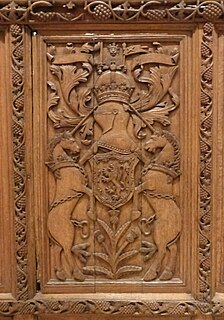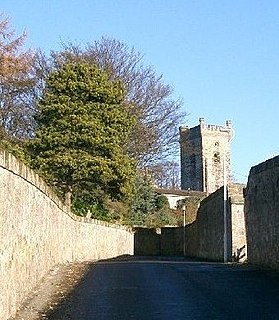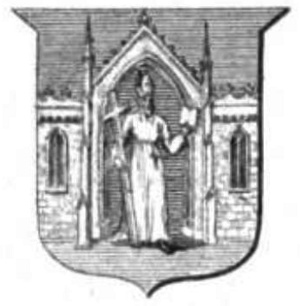William Sinclair (1410–1484), 1st Earl of Caithness (1455–1476), last Earl (Jarl) of Orkney, Baron of Roslin, was a Norwegian and Scottish nobleman and the builder of Rosslyn Chapel, in Midlothian.

The title Earl of Moray ("Murray") has been created several times in the Peerage of Scotland. It has been held by Clan Stewart since the 16th century, when James Stewart, illegitimate son of James V, was granted the title.

The office of Keeper of the Privy Seal of Scotland, one of the Great Officers of State, first appears in the reign of David II. After the Act of Union 1707 its holder was normally a peer, like the Keeper of the Great Seal. The office has remained unfilled since the death of Gavin, Marquess of Breadalbane in 1922.
The Abbot of Kelso was the head of the Tironensian monastic community at Kelso Abbey in the Scottish Borders. Originally, he was the Abbot of Selkirk, because from its foundation in 1113 by David, Prince of the Cumbrians (1113–1124) until it was moved to Kelso by David and John, bishop of Glasgow in 1127. The abbot was the first in Scotland to be granted the mitre in 1165. In the 16th century the monastery increasingly came under secular control, and finally in 1607 it was granted as a secular lordship (Holydean) to its last commendator, Robert Ker of Cesford, later earl of Roxburghe. The following is a list of abbots and commendators:

The Abbot and then Commendator of Culross was the head of the monastic community of Culross Abbey, Fife, Scotland. The abbey was founded in 1218 on the patronage of Maol Choluim I, Earl of Fife by Cistercian monks from Kinloss Abbey, Moray. Control of the abbey was secularized in the 16th century and after the accession of James Stewart, the abbey was held by commendators. The number of monks under the abbot had also declined by the 16th century, there being only 15 monks by 1557.
The Prior of St Andrews was the head of the property and community of Augustinian canons of St Andrews Cathedral Priory, St Andrews, Fife, Scotland. It was established by King David I in 1140 with canons from Nostell Priory, West Yorkshire. It is possible that, initially at least, the prior of St Andrews was subordinate to the bishop as abbot, but by the 13th century the canons of St Andrews were given freedom by the bishop to elect their prior. By the end of the 13th century, the abbacy of the native canons was no longer there to challenge the position of the priory, and the native canons themselves had been formed into a collegiate church.
The Archdeacon of Lothian was the head of the Archdeaconry of Lothian, a sub-division of the Diocese of St Andrews. The position was one of the most important positions within the medieval Scottish church; because of his area's large population and high number of parish churches, the Archdeacon of Lothian may have exercised more power than many Scottish bishops before the decline in archdiaconal powers after the 13th century.
The Archdeacon of St Andrews was the head of the Archdeaconry of St Andrews, a sub-division of the Diocese of St Andrews, from the twelfth to the seventeenth century. The position was one of the most important positions within the medieval Scottish church; because of his area's large population and high number of parish churches, the Archdeacon of St Andrews may have exercised more power than many Scottish bishops. The following is a list of known archdeacons:
The Archdeacon of Glasgow was the head of the Archdeaconry of Glasgow, a sub-division of the Diocese of Glasgow. He was one of two archdeacons serving the Bishop of Glasgow, the other one being the Archdeacon of Teviotdale. This archdeacon (Glasgow) was responsible for region of the Diocese of Glasgow outside the Teviotdale region of the Scottish Borders region. The position was an important position within the medieval Scottish church, because of the high number of parish churches in the archdeaconry.
The Archdeacon of Dunkeld was the only archdeacon in the Diocese of Dunkeld, acting as a deputy of the Bishop of Dunkeld. The following is a list of archdeacons:
The Prior of Pluscarden was the head of the monastic community and lands of Pluscarden Priory, Moray, Scotland. The Priory was founded in 1230 by King Alexander II of Scotland for the Valliscaulian Order. In March 1454 it incorporated the foundering neighbouring establishment of Urquhart Priory and became a dependency of Dunfermline Abbey, whence it became Benedictine. The following are a list of abbots and commendators:
The Archdeacon of Ross was the only archdeacon in the medieval Diocese of Ross, acting as a deputy of the Bishop of Ross. The following is a list of archdeacons:
The Archdeacon of Caithness was the only archdeacon in the Diocese of Caithness, acting as a deputy of the Bishop of Caithness. The following is a list of known historical archdeacons:
The Archdeacon of Aberdeen was the only archdeacon in the Diocese of Aberdeen, acting as a deputy of the Bishop of Aberdeen. The archdeacon held the parish church of Rayne as a prebend since 1256. The following is a list of known historical archdeacons:
The Archdeacon of Shetland was the head of the Archdeaconry of Shetland, a sub-division of the Diocese of Orkney in Scotland This archdeacon was one of the two archdeacons of the diocese, the other being the Archdeacon of Orkney. Next to the bishop, the Archdeacon of Shetland was the senior ecclesiastic in the diocese.
John Russell was an English Bishop of Rochester and bishop of Lincoln and Lord Chancellor.
The Archdeacon of Brechin was the only archdeacon in the diocese of Brechin, acting as a subordinate of the Bishop of Brechin. The archdeacon held the parish church of Strachan as a prebend from at least 1274.
The Archdeacon of Argyll was the only archdeacon in the diocese of Argyll, acting as a subordinate of the Bishop of Brechin. Regarding his supporting churches, it is known that archdeacon held a quarter of parish church of Eilean Munde as a prebend.
The Archdeacon of the Isles was the only archdeacon in the diocese of the Isles, acting as a subordinate of the Bishop of the Isles. The number and names of the prebends, if any, associated with the archdeaconry in the later Middle Ages are not known. Before the break-away of the diocese of Man during the Western Schism, the archdeacons held Kirk Andreas as a prebend. The office seems to have fallen into disuse after the time of Alasdair Caimbeul, who received crown presentation to the position in 1592. It was to be revived in 1662.



